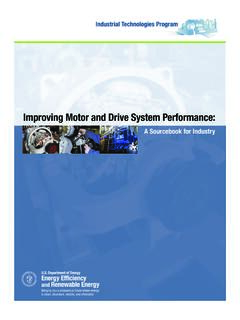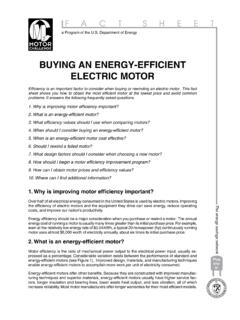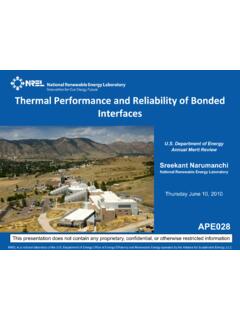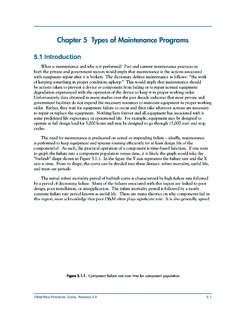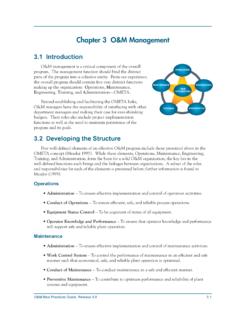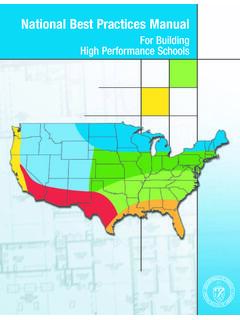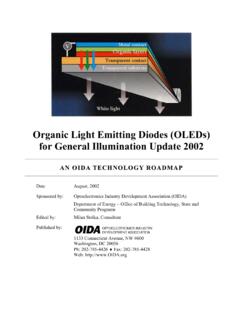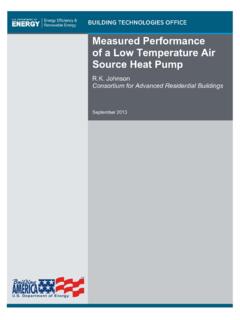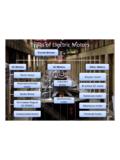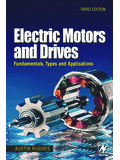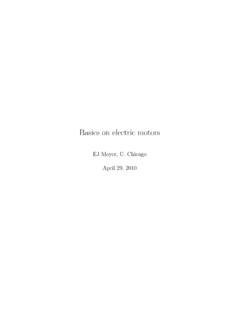Transcription of Determining Electric Motor Load and Efficiency
1 A Program of the Department of EnergyFACT SHEETThe energy savings networkPlugintoit!DEPARTMENTOFENERGYUNIT EDSTATESOFAMERICADETERMINING Electric MOTORLOAD AND EFFICIENCYMost likely your operation s motors account for a large part of your monthly Electric bill. Far too oftenmotors are mismatched or oversized for the load they are intended to serve, or have been re-wound multiple compare the operating costs of an existing standard Motor with an appropriately-sized energy-efficient replacement, you need to determine operating hours, Efficiency improvement values, andload.
2 Part-load is a term used to describe the actual load served by the Motor as compared to therated full-load capability of the Motor . Motor part-loads may be estimated through using input power,amperage, or speed measurements. This fact sheet briefly discusses several load estimation to Determine Motor LoadingMost Electric motors are designed to run at 50% to 100% of rated load. Maximum Efficiency isusually near 75% of rated load. Thus, a 10-horsepower (hp) Motor has an acceptable load range of5 to 10 hp; peak Efficiency is at hp.
3 A Motor s Efficiency tends to decrease dramatically belowabout 50% load. However, the range of good Efficiency varies with individual motors and tends toextend over a broader range for larger motors, as shown in Figure 1. A Motor is consideredunderloaded when it is in the range where Efficiency drops significantly with decreasing load. Fig-ure 2 shows that power factor tends to drop off sooner, but less steeply than Efficiency , as 1 Motor Part-Load Efficiency (as a Function of % Full-Load Efficiency )0-1 hp15-25 hp75-100 hp10 hp 30-60 hpPercent Full-Load EfficiencyPercent Full Load100%100%120%60%60%40%40%20%20%0%0%80 %80%Load Ranges:Acceptable Short-PeriodAcceptable OperatingOptimum2 Figure 2 Motor Power Factor (as a Function of % Full-Load Amperage)Overloaded motors can overheat and lose Efficiency .
4 Many motors are designed with a service factor thatallows occasional overloading. Service factor is a multiplier that indicates how much a Motor can be overloadedunder ideal ambient conditions. For example, a 10-hp Motor with a service factor can handle an loadfor short periods of time without incurring significant damage. Although many motors have service factors , running the Motor continuously above rated load reduces Efficiency and Motor life. Never operate over-loaded when voltage is below nominal or when cooling is impaired by altitude, high ambient temperature, or dirtymotor your operation uses equipment with motors that operate for extended periods under 50% load, consider makingmodifications.
5 Sometimes motors are oversized because they must accommodate peak conditions, such aswhen a pumping system must satisfy occasionally high demands. Options available to meet variable loadsinclude two-speed motors, adjustable speed drives, and load management strategies that maintain loads withinan acceptable if your motors are properly loaded enables you to make informed decisions about when to replacemotors and which replacements to choose. Measuring Motor loads is relatively quick and easy when you use thetechniques discussed in this fact sheet.
6 You should perform a Motor load and Efficiency analysis on all of yourmajor working motors as part of your preventative maintenance and energy conservation program. Use Attach-ment A, Motor Nameplate and Field Test Data Form, to record Motor nameplate data and field recommend that you survey and test all motors operating over 1000 hours per year. Using the analysisresults, divide your motors into the following categories: Motors that are significantly oversized and underloaded replace with more efficient, properly sized models atthe next opportunity, such as scheduled plant downtime.
7 Motors that are moderately oversized and underloaded replace with more efficient, properly sized modelswhen they fail. Motors that are properly sized but standard Efficiency replace most of these with energy-efficient models whenthey fail. The cost effectiveness of an energy-efficient Motor purchase depends on the number of hours the motoris used, the price of electricity, and the price premium of buying an energy-efficient Motor . Use Attachment B, the Motor Energy Savings Calculation Form, to determine the cost effectiveness of Motor changeout hp150 hp100-125 hp40-75 hp15-30 hp5-10 hpPower FactorPercent Full-Load Amperage100%60%40%20%0%35%45%55%65%75%85 %95%100%80%3 Determining Motor LoadsInput Power MeasurementsWhen direct-read power measurements are available, use them to estimate Motor part-load.
8 With measuredparameters taken from hand-held instruments, you can use Equation 1 to calculate the three-phase input powerto the loaded Motor . You can then quantify the Motor s part-load by comparing the measured input power underload to the power required when the Motor operates at rated capacity. The relationship is shown in Equation 1 Equation 2 Equation 3Pi =V x I x PF x 31000 Where:Pi= Three-phase power in kWV= RMS voltage, mean line-to-line of 3 phasesI= RMS current, mean of 3 phasesPF= Power factor as a decimalWhere:Pir= Input power at full-rated load in kWhp= Nameplate rated horsepower fl= Efficiency at full-rated loadPir = hp flWhere.
9 Load = Output power as a % of rated powerPi= Measured three-phase power in kWPir= Input power at full-rated load in kWLoad =PiPirx 100%4 Line Current MeasurementsThe current load estimation method is recommended when only amperage measurements are available. Theamperage draw of a Motor varies approximately linearly with respect to load, down to about 50% of full load. (SeeFigure 3.) Below the 50% load point, due to reactive magnetizing current requirements, power factor degradesand the amperage curve becomes increasingly non-linear.
10 In the low load region, current measurements are nota useful indicator of 3 Relationships Between Power, Current, Power Factor and Motor LoadExample: Input Power CalculationAn existing Motor is identified as a 40-hp, 1800 rpm unit with anopen drip-proof enclosure. The Motor is 12-years old and hasnot been electrician makes the following measurements:Measured Values:V ab = 467VI a = 36 ampsPF a = bc = 473VI b = 38 ampsPF b = ca = 469VI a = 37 ampsPF c = = (467+473+469)/3 = voltsI = (36+38+37)/3 = 37 ampsPF = ( + + )/3 = 1 x 37 x x 31000Pi == kW5 Nameplate full-load current value applies only at the rated Motor voltage.
